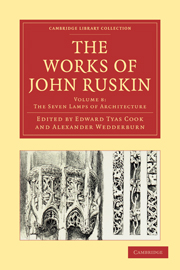Book contents
- Frontmatter
- Contents
- LIST OF ILLUSTRATIONS
- INDEX TO THE PLATES
- INTRODUCTION TO THIS VOLUME
- BIBLIOGRAPHICAL NOTE
- THE SEVEN LAMPS OF ARCHITECTURE
- AUTHOR'S PREFACE TO THE FIRST EDITION (1849)
- AUTHOR'S PREFACE TO THE SECOND EDITION (1855)
- AUTHOR'S PREFACE TO THE EDITION OF 1880
- The Seven Lamps of Architecture (CONTAINING THE TEXT OF ALL THE EDITIONS)
- APPENDIX
- Plate section
INTRODUCTION TO THIS VOLUME
Published online by Cambridge University Press: 05 November 2011
- Frontmatter
- Contents
- LIST OF ILLUSTRATIONS
- INDEX TO THE PLATES
- INTRODUCTION TO THIS VOLUME
- BIBLIOGRAPHICAL NOTE
- THE SEVEN LAMPS OF ARCHITECTURE
- AUTHOR'S PREFACE TO THE FIRST EDITION (1849)
- AUTHOR'S PREFACE TO THE SECOND EDITION (1855)
- AUTHOR'S PREFACE TO THE EDITION OF 1880
- The Seven Lamps of Architecture (CONTAINING THE TEXT OF ALL THE EDITIONS)
- APPENDIX
- Plate section
Summary
This volume, containing The Seven Lamps of Architecture, follows, in the chronological order of Ruskin's principal works, the second volume of Modern Painters (Vol. IV.). That volume was published in 1846; no further portion of Modern Painters saw the light until 1856. During the intervening decade, the magnum opus was never wholly out of the author's mind, but its place of precedence was for a while usurped by other thoughts and tasks. “It is curious,” he notes in his diary of 1849, “that in literature the most successful books seem to have been planned as they went on.” Not Ruskin's books only, but the order in which he wrote them, were planned as he went on, and his mental journeying at no time was free from digressions. At the end of the second volume of Modern Painters, he was rapt in contemplation of “the angel choirs” of the early Italian painters. He followed up that volume by some minor writings on allied subjects to which we shall presently allude; but these were anonymous, and when he next appeared before the public with another volume, it was found to be devoted to the principles and ideals of Gothic architecture. This new study occupied him for seven years, and its results were embodied in five illustrated volumes—The Seven Lamps of Architecture (1849), The Stones of Venice, vol. i. (1851), Examples of the Architecture of Venice (1851), and The Stones of Venice, vols. ii. and iii. (1853).
- Type
- Chapter
- Information
- The Works of John Ruskin , pp. xix - lPublisher: Cambridge University PressPrint publication year: 2010First published in: 1903



